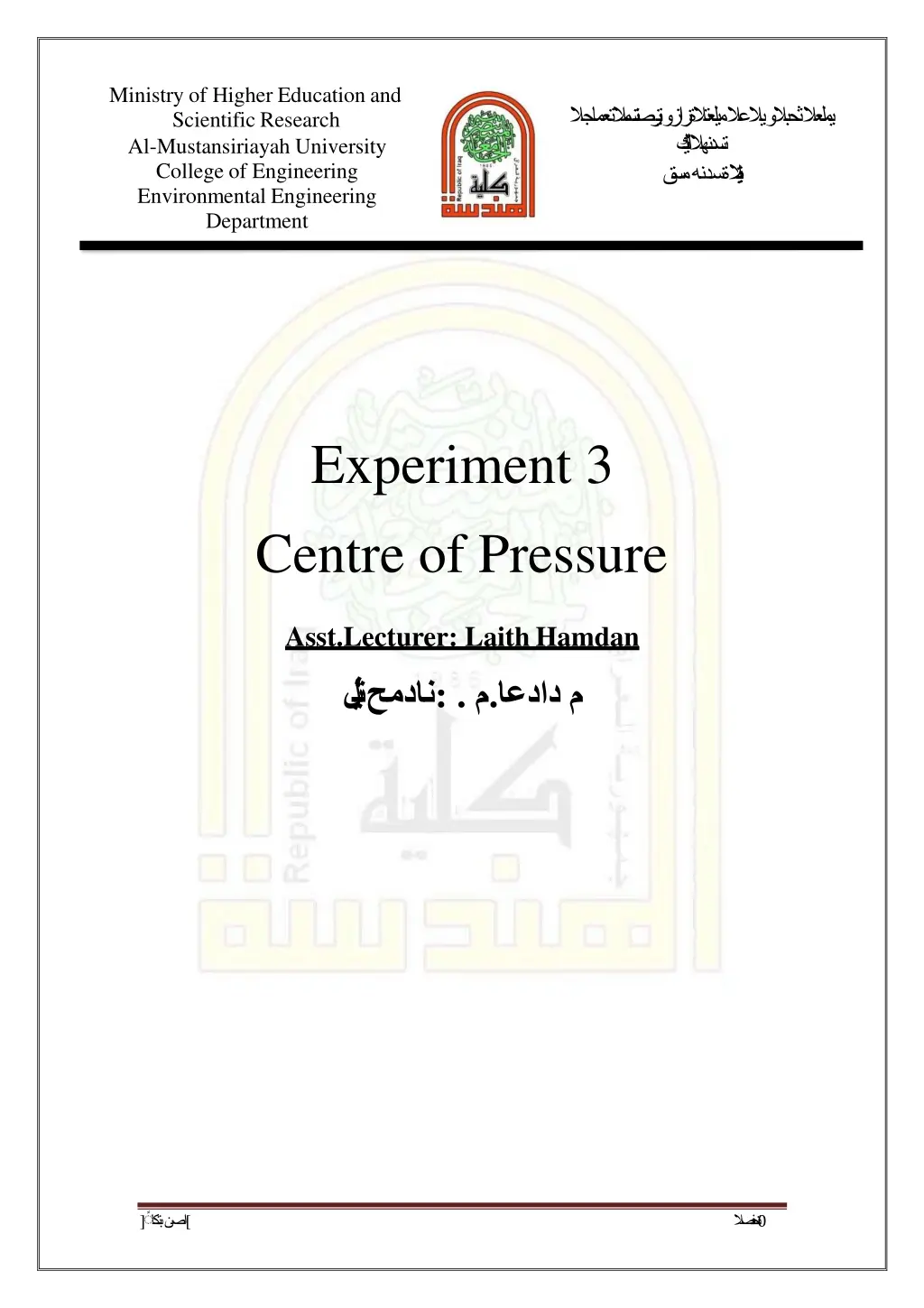
Experiment on Center of Pressure in Hydrostatic Force
"Discover the experimental and theoretical center of pressure in hydrostatic forces applied on submerged surfaces. Follow a detailed procedure to determine resultant forces and calculate equilibrium conditions. Learn the theoretical background and calculations involved in this intriguing experiment."
Download Presentation

Please find below an Image/Link to download the presentation.
The content on the website is provided AS IS for your information and personal use only. It may not be sold, licensed, or shared on other websites without obtaining consent from the author. If you encounter any issues during the download, it is possible that the publisher has removed the file from their server.
You are allowed to download the files provided on this website for personal or commercial use, subject to the condition that they are used lawfully. All files are the property of their respective owners.
The content on the website is provided AS IS for your information and personal use only. It may not be sold, licensed, or shared on other websites without obtaining consent from the author.
E N D
Presentation Transcript
Ministry of Higher Education and Scientific Research Al-Mustansiriayah University College of Engineering Environmental Engineering Department Experiment 3 Centre of Pressure Asst.Lecturer: LaithHamdan : . . ] 0 [
Objectives: 1To determine experimentally the resultant hydrostatic force (total force) applied on a submerged surface. 2 To determine the experimental and the theoretical center of pressure. Equipments and apparatus: 1- Center of pressure device, consists of: a- Quadrant. b- Balance arm. c- Balancepan. d-Adjustable counter balance. e- Drainvalve. f- Leveling feet. g- Weights. 2- Hydraulic bench (Measuring tank). Asst.Lecturer: LaithHamdan 1
Procedure: 1 Place the empty tank on the Bench and position the balance arm on the pivot. 2Place the balance pan in the groove at the end of the balance arm. 3- Level thetank. 4 Position the counterbalance weight until the balance arm is horizontal. 5 Add a known amount of weight to the balance pan. Pour water into the tank until the balance arm is horizontal again. (Note: it may be easier to overfill then use the drain to level it.) 6 When the arm is level, this means that the force on the vertical face of the quadrant balances out the force due to the added weight. 7Read the depth of immersion from the scale on the face of the quadrant. 8- Repeat the experiment by adding more weights (increments of 50should work fine) until you have at least two measurements in which the vertical face is completely submerged. 9- Calculate the magnitudes and locations of the forces for each weight combination. 10-Compare these locations with the theoretical positions. Asst.Lecturer: LaithHamdan 2
Theoretical background and Calculation: 1. Partly submerged vertical plane surface (Newtons) Where A = B x d and d = depth of immersion. See figure above. And = depth of the centroid of the submerged area C, = d/2 Thus . Eq.1 Moment of thrust about pivot Moment M = F x h (Nm) Where h = depth of line of action of thrust below pivot. I.e. center of pressure P. Asst.Lecturer: LaithHamdan 3
Equilibrium condition A balancing moment is produced by the weight (W) applied to the hanger at the end of the balance arm = W x L (Nm). For static equilibrium the two moments are equal. i.e. F x h = W x L = m x g x L (m = applied mass) Thus h = = (meters) ...Eq. 2 Remember, so h = , the gravity terms cancel, leaving you with ..Eq. 2 The theoretical result for depth of center of pressure, P, below the free-surface of the fluid is: h = .Eq. 3 where Ix = 2nd moment of area of immersed section about an axis in the free water surface. So (using the parallel axis theorem) (m4) Thus which= .. Eq. 4 The depth of P below the pivot point will be: h = h + H - d (m) and if you substitute Eq. 4 into Eq.3 you will get : h = H - d/3 as the theoretical result. Asst.Lecturer: LaithHamdan 4
In other words, the distance from the pivot to the center of pressure is the depth to the bottom of the vertical plane, minus one third the depth of the submerged part of the vertical plane. So the center of pressure on a partially submerged plane will always be one third of d up from the base of the plane surface. However, when the plane is fully submerged, you now have to include the additional depth from the free water surface to the top of the vertical plane. 2. Fully submerged vertical plane surface Hydrostatic thrust, (Newtons) Where A = B x D and D = depth of vertical surface. See figure above. And = depth of the centroid of the submerged area C, = Thus, (Newtons) Moment of thrust about pivot Moment M = F x h (Nm) As in previous part. Equilibrium condition As before, a balancing moment is produced by the weight (W) applied to the hanger at the end of the balance arm = W x L (Nm). For static equilibrium the two moments are equal. i.e. F x h = W x L = m x g x L (m = applied mass) Asst.Lecturer: LaithHamdan 5
But this time h = = (meters) The theoretical result for depth of center of pressure, P, below the free-surface of the fluid is: h = where Ix = 2nd moment of area of immersed section about an axis in the free water surface. Thus: (using the parallel axis theorem) (m4) Thus So, the depth of P below the pivot point will be: h = h + H - d (m) but it does not simplify as before. Asst.Lecturer: LaithHamdan 6
7 Asst.Lecturer: LaithHamdan






















